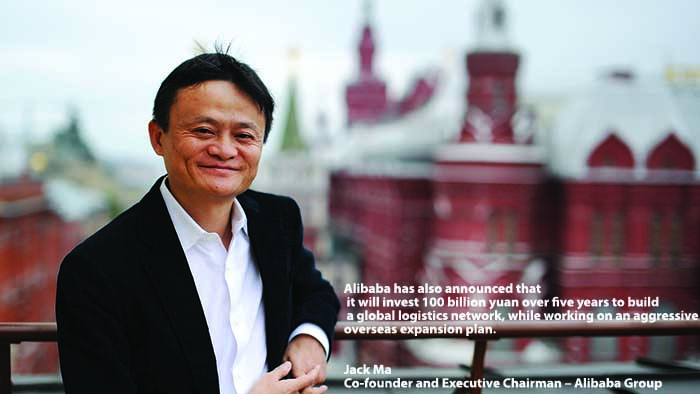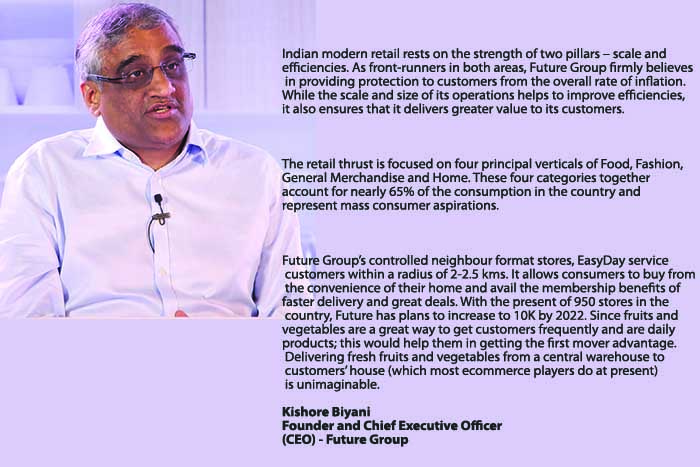E-commerce In India: Unlimited Opportunity
VARINDIA- INDIA'S FRONTLINE IT MAGAZINE





India’s e-commerce industry is transforming to the next era of transformation. It is like who can take maximum attention of the prospective buyer by using various technology tools. The war is between two super powers – USA and China and among Amazon, Alibaba and Walmart. To make the shopping experience more convenient, brick and mortar developers are focusing on enhancing the convenience of shopping centre automate mode. Experts say that India is poised to become one of the largest and fastest e-commerce growth markets in the next decade. The Government of India is also supporting this growth wave by permitting foreign retailers to own stakes of as much as 51% in multi-brand retail ventures, after securing government approval.
The online retail sector is expected to grow at 30% a year to reach a gross merchandise value of $200bn by 2026. With 1.3 billion population, India sees a rapid growth of internet users, with 430 million people in India having access to the internet, which is a third of the South Asian country’s population. It is the most promising market in the globe and no one wants to miss the bus.
India’s retail boom is being driven by resurgence in the economy. Modern retail still has around 6% share of the total retail spend in the country that is estimated at around US $400 billion. Thus, the potential for modern retail growth in India is huge. Currently, leading retailers in mature markets occupy the top three slots by turnover, employment and value creation. As the Indian economy matures, it is upon us to make the same happen in our country.
Post-acquisition of Flipkart by US retail giant Walmart (having taken a 77% stake for $16 billion), the industry fears that the latter will penetrate the retail trade through e-commerce, and indulge in predatory pricing and deep discounting, thereby creating an uneven playing field for others. It will source globally the cheapest material and will dump in the country to wipe out the competition. As of now, no rule or law exists which can put restrictions on such practises of any company.
With the recent launch of Flipkart’s 2GUD to target the pre-used products/ refurbished products that includes smartphones, laptops, headphones, watches, small appliances and many more, the pre-owned devices market can be said to be slowly opening up in India. The refurbished goods market in India will be worth an estimated $20 billion in the next five to six years.
Some say that Old is Gold but very Old is Roll Gold. Here we need to understand whether the old devices are from inside the country or they are imported from other country and are sold in India through on-line and off-line. A time will come even foreign investment partners like Walmart will manage to do the supply chain from outside of the country. This will give the buyers the option of buying new/old products from online. However, security will be a great concern over the pre-owned products.
It will be a very difficult task for the authority to maintain a check and balance to understand whether any new or old products are getting shipped into the country. Can we say then that there is no grey market; rather when you buy the pre-owned devices online, it will become legal. The policy makers have already formalized the draft accordingly, but the e-commerce player has to show very clearly in its website, whether it is a new or an old product.
The Indian e-commerce market is at an inflection point, thanks largely to the disruption of the telecom landscape, with dramatic reduction in data rates and rapid adoption of 4G smartphones and feature phones.
Amazon vs. Alibaba in India…
The key to Amazon’s strategy in India is its ability to think globally but act locally – leveraging its massive scale, logistics capabilities and balance sheet while creating customized local offerings developed ground-up for the Indian market. This “Glocal” strategy is in sharp contrast with other U.S. companies.
Amazon entered the India space in 2013; it is the second big player in India currently worth $16 billion, already deeply committed to the country, where it has pledged to deploy more than $5 billion to grow its business. In this short span of 5 years it has captured about 30% market share in the Indian ecommerce market, and is poised to grow that 23% annually until 2027. After picking 10 percent stake in Shopper Stop for 180 crore approx. last year, Amazon already kicked off investment in India’s $70 billion retail market. Now, Amazon is in talks with Future group to buy 10% stake in the company for an amount of $600 Million.

Recently, Amazon is on the advance foot step to acquire 42-49% in Aditya Birla Retail entity – More supermarket chain. Amazon is also joining hands with India-focused private equity firm Samara Capital for a complete buyout of More from the Aditya Birla Group for ₹4,200-4,400 crore. Amazon’s team speaks of the value that they are creating for consumers and sellers. It seems a lot of hard work has gone into offering the Go-local strategy.
Technology plays a crucial role in defining the business criticality; there is no doubt on Amazon pioneering in understanding the power of AI and technology disruption. With the help of Amazon Web Services (AWS), a subsidiary of Amazon.com, it started the mission long back to prepare an industry-ready workforce and nurture start-ups in the country to nurture talent in India. Amazon Web Services (AWS) is a comprehensive, evolving cloud computing platform provided by Amazon. It provides a mix of infrastructure as a service (IaaS), platform as a service (PaaS) and packaged software as a service (SaaS) offerings.
The company is working very closely with the entire accelerator and incubator space in India. AWS has various programmes that it runs in India that help all the stakeholders further drive invested or incubated companies move forward on new-age technologies.
The fact is India is an open market and opportunity is available for everyone to explore with their innovative marketing strategies.
In the case of Alibaba, the global e-commerce giant is increasing its investment to support its New Retail strategy – a series of initiatives to integrate the online and offline shopping experiences for consumers across a number of products and services, which is the reality of life.
Alibaba’s core commerce revenue rose 61 per cent to 69.2 billion yuan by creating a formidable omni channel (aka O2O) business in China through its ecosystem consisting of payments, supply chain, and offline retail. It further created 31 million jobs in China, with the unique business module. Alibaba is seeing great success by adopting an ‘online-to-offline’ model in China to support the unorganised and small to medium retail business. “Omni-channel or multi-channel retailing” provides shoppers with a consistent and seamless buying experience across online and offline stores, which it wants to replicate in India, by giving jobs to the youngsters. This seems possible by taking the route to invest in companies like Reliance Group, Tata Group and Future Retail.
Strong investments by Alibaba into various ventures in India have proved its uniqueness – Jack Maa, the founder of Alibaba has better understood India to succeed the India business through its Omni-channel model.
A major chunk of online retailers in India have realised that India can’t be built without strong offline support. Right from Amazon to Myntra, Pepperfry including many others are slowly leveraging offline outlets as experience centres as well as a medium of sales channel. Paytm Mall recently also expressed interest in launching a physical store. The idea is simple – when every e-commerce company is selling at a cheap price, then the choice of the consumer will shift towards trust and brand evaluation.
Alibaba has been pushing plans in India since Walmart acquired Flipkart and the strong focus of Amazon by increasing investment up to $5Bn in the last five years of its operations. According to the report, Alibaba is also planning to hold talks with other companies beyond Future Group, Reliance and Tata. The question is with whom the deal is going close.
Alibaba is exploring joint venture with Reliance Retail to form a mega Indian retail joint venture (JV), with an investment of at least $5 billion plus to challenge the dominance of Flipkart and Amazon in the world’s fastest-growing economy. It is also focusing on using the older investments in Paytm Mall, Zomato, Big Basket and TicketNew to propose new partnerships and open a new synergy. It has been pushing Paytm Mall to approach the market with the O2O model which is running successfully in China, unlike other players who rely on a mix of inventory and marketplace model in India.
“Our New Retail initiatives are substantially growing Alibaba’s total addressable market in e-commerce,” Joseph Tsai, the executive vice-chairman at Alibaba said.
Lastly, Alibaba has also announced that it will invest 100 billion yuan over five years to build a global logistics network, while working on an aggressive overseas expansion plan.
The Big O2O (Online to Offline) story
Amazon is currently the second biggest player in India worth $16 billion, and has pledged to deploy more than $5 billion to grow its business. After picking 10 percent stake in Shopper Stop for 180 crore approx. , Amazon is in talks with Future group to buy 10% stake in the company for an amount of $600 Million.
Alibaba is exploring joint venture with Reliance Retail to form a mega Indian retail joint venture (JV), with an investment of at least $5 billion plus. t is also focusing on using the older investments in Paytm Mall, Zomato, Big Basket and TicketNew to propose new partnerships.
Offline retail subsidiary of Reliance Industries, Reliance Retail has forayed into online sales of smartphones and electronic appliances. To complement this, Reliance Digital and smaller Jio stores act as fulfilment centres for the online orders.
Future Group plans to open 10,000 Easyday stores to make it a Rs 1.5-trillion business opportunity by 2022 as part of its Retail 3.0 vision. Each such store will have an investment of around Rs 15 lakh.
Advantage Reliance Digital…
With the strong omni-channel expansion of Reliance Digital, it now becomes India’s largest electronic brick-and-mortar retail chain. It has disrupted the market with its low-cost business models targeting the masses and aggressive pricing in its offline stores. It is expected that by the festive season Reliance Digital will look at acquiring a significant market share in the consumer electronics and smartphones sector by giving a strong competition to Flipkart and Amazon.
Reliance Retail, the offline retail subsidiary of India’s top billionaire Mukesh Ambani’s Reliance Industries has forayed into online sales of smartphones and electronic appliances such as refrigerators, air conditioners, and televisions. To complement this, Reliance Digital and smaller Jio stores act as fulfilment centres for the online orders. Reliance Digital has 305 + brick-and-mortar stores in India and Jio is the Reliance Industries-owned mobile network operator which sells its offerings through more than 1700 stores across the country.
Whereas, Reliance Retail is the largest retailer in India in terms of revenue, its retail outlets offer food, groceries, apparels, lifestyle and home-care products, consumer electronics, farm implements and so on. Reliance Retail is doing a great business in India of Rs. 2,529 cr. PBITA, as of 31st march 2018 and is present in 5,200 towns and cities, with 8,533 stores including 4,530 Jio Points. The number is still increasing.
Also with Alibaba Group proposing to acquire a large stake in Reliance Retail to create a behemoth in the digital marketplace and also expand Alibaba’s physical retail businesses in India, this might sound the arrival of two deep-pocketed companies planning to come together to take on the market leaders.

Advantage Future Group…
